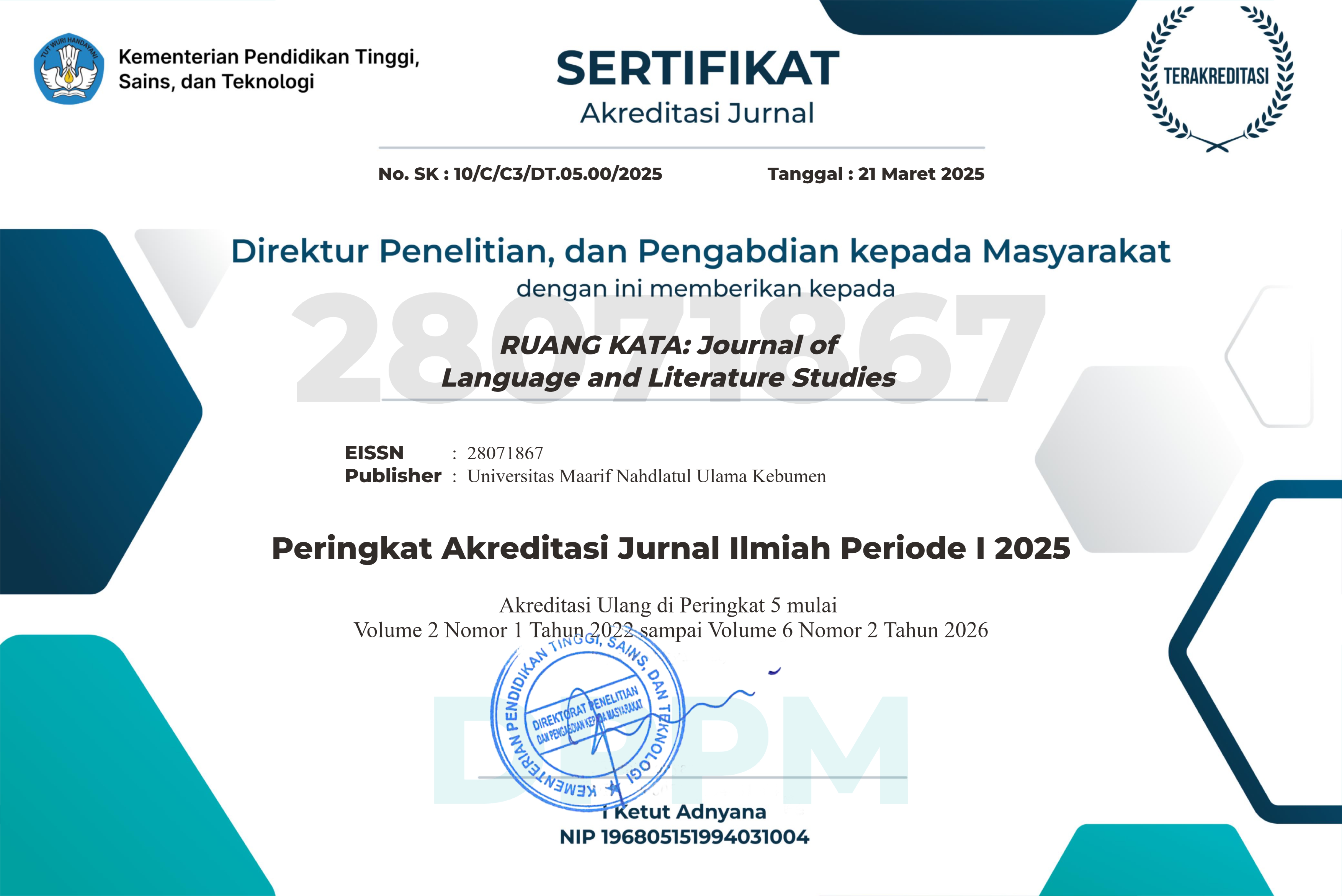Representasi Kekerasan dalam Rumah Tangga pada Kumpulan Cerpen Kembang Selir Karya Muna Masyari
DOI:
https://doi.org/10.53863/jrk.v5i01.1564Keywords:
Representation, Domestic Violence, A Collection of Short Stories Kembang Selir, Muna MasyariAbstract
This research departs from the depiction of domestic violence in literary works that cause a household to experience disharmony. On this basis, the purpose of this research is to describe domestic violence contained in literary works. This research is included in qualitative descriptive research with the object of research in the form of a description of domestic violence which is studied based on forms of domestic violence such as physical, psychological, sexual violence and domestic neglect. The book of short stories Kembang Selir by Muna Masyari published by the publisher DIVA Perss in 2023 was determined as a data source in conducting this research.. The research data was obtained from words, phrases, sentences, paragraphs, metaphors, dialogues, and monologues that contain descriptions of domestic violence in the short story collection book Kembang Selir by Muna Masyari. The data collection technique is carried out by reading, listening, and taking notes. Triangulation is used as a data validity technique in conducting research. Then, the analysis of research data uses three stages, namely: data reduction, data presentation, and data verification. The results of this study show that there are depictions of domestic violence in several short stories contained in the collection of short stories Kembang Selir by Muna Masyari, namely: 1) The short story "Lorong Suram" contains depictions of domestic violence in the form of physical and psychological violence. 2) The short story "Perempuan Penunggu" contains depictions of physical and psychological violence. 3) The short story "Gelas dan Piring" contains an image of domestic violence in the form of psychological violence, and 4) The short story "Bayi Sunarti" contains a description of domestic violence in the form of domestic neglect
References
Al-Ma’ruf, A. I., & Nugrahani, F. (2021). Pengkajian Sastra: Teori dan Aplikasi. Surakarta: CV. Djiwa Amarta Press.
Alfadila, A. E., & Purnomo, B. (2021). Konflik Rumah Tangga dalam Novel Mendhung Sumilak Karya JMV Sunarjo. JOB (Jurnal Online Baradha), 17(3), 1151–1174.
Endraswara, S. (2013). Metodologi Penelitian Sastra: Epistemologi, Model, Teori, dan Aplikasi. Jakarta: Media Pressindo.
Ghozali, F. (2017). Kekerasan dalam Rumah Tangga pada Kumpulan Cerpen Rahasia Selma karya Linda Christanty dan Implikasinya Terhadap Pembelajaran Sastra di Sekolah. Institutional Repository UIN Syarif Hidayatullah. Jakarta: Fakultas Ilmu Tarbiyah dan Keguruan.
Khaleed, B. (2015). Penyelesaian Hukum KDRT: Penghapusan Kekerasan dalam Rumah Tangga dan Upaya Pemulihannya. Yogyakarta: Penerbit Pustaka Yustisia.
Nazilah, P. F. (2023). Fenomena Kekerasan dalam Rumah Tangga pada Perempuan dalam Kumpulan Cerpen Kitab Kawin Karya Laksmi Pamuntjak (Kajian Feminisme). Padang: Universitas Pamulang Digital Repository.
Nurgiyantoro, B. (2015). Teori Pengkajian Fiksi. Yogyakarta: Gadjah Mada University Press.
Rafiek, M. (2010). Teori Sastra: Kajian Teori dan Praktik. Bandung: PT Refika Aditama.
Rizki, P. O., & Israhayu, E. S. (2024). Teknik Pelukisan Tokoh dalam Novel Cantik Itu Luka Karya Eka Kurniawan. Jurnal Membaca Bahasa & Sastra Indonesia, 9(November), 159–168.
Safari, D. M., Ilman, M. Z., & Moenir, A. (2020). Kekerasan dalam Rumah Tangga pada Novel Pintu Terlarang Karya Sekar Ayu Asmara. Jurnal Ilmiah Humanika, 3(1), 62–71.
Semi, M. A. (2012). Metode Penelitian Sastra. Bandung: CV Angkasa.
Zanah, G. R., & Nurbaetillah, S. (2023). Problematika Perlindungan Hukum Terhadap Perempuan dan Anak Sebagai Korban Tindak Pidana Kekerasan dalam Rumah Tangga (KDRT). ULIL ALBAB: Jurnal Ilmiah Multidisiplin, 3(1), 35–44.
Downloads
Published
How to Cite
License
Copyright (c) 2025 Yuyun Wulandari, Eko Sri Israhayu

This work is licensed under a Creative Commons Attribution-ShareAlike 4.0 International License.
Authors retain copyright and grant the journal right of first publication with the work simultaneously licensed under a Creative Commons Attribution-ShareAlike 4.0 International License that allows others to share the work with an acknowledgment of the work’s authorship and initial publication in this journal














